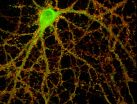(Press-News.org) Folsom, Calif., (October 21, 2014) – A new animal study published in the Journal of Alzheimer's Disease indicates that a diet including walnuts may have a beneficial effect in reducing the risk, delaying the onset, slowing the progression of, or preventing Alzheimer's disease.
Research led by Abha Chauhan, PhD, head of the Developmental Neuroscience Laboratory at the New York State Institute for Basic Research in Developmental Disabilities (IBR), found significant improvement in learning skills, memory, reducing anxiety, and motor development in mice fed a walnut-enriched diet.
The researchers suggest that the high antioxidant content of walnuts (3.7 mmol/ounce)1 may have been a contributing factor in protecting the mouse brain from the degeneration typically seen in Alzheimer's disease. Oxidative stress and inflammation are prominent features in this disease, which affects more than five million Americans2.
"These findings are very promising and help lay the groundwork for future human studies on walnuts and Alzheimer's disease – a disease for which there is no known cure," said lead researcher Dr. Abha Chauhan, PhD. "Our study adds to the growing body of research that demonstrates the protective effects of walnuts on cognitive functioning."
The research group examined the effects of dietary supplementation on mice with 6 percent or 9 percent walnuts, which are equivalent to 1 ounce and 1.5 ounces per day, respectively, of walnuts in humans. This research stemmed from a previous cell culture study3 led by Dr. Chauhan that highlighted the protective effects of walnut extract against the oxidative damage caused by amyloid beta protein. This protein is the major component of amyloid plaques that form in the brains of those with Alzheimer's disease.
Someone in the United States develops Alzheimer's disease every 67 seconds, and the number of Americans with Alzheimer's disease and other dementias are expected to rapidly escalate in coming years as the baby boom generation ages. By 2050, the number of people age 65 and older with Alzheimer's disease may nearly triple, from five million to as many as 16 million, emphasizing the importance of determining ways to prevent, slow or stop the disease. Estimated total payments in 2014 for all individuals with Alzheimer's disease and other dementias are $214 billion2.
Walnuts have other nutritional benefits as they contain numerous vitamins and minerals and are the only nut that contains a significant source of alpha-linolenic acid (ALA) (2.5 grams per ounce), an omega-3 fatty acid with heart and brain-health benefits4,5. The researchers also suggest that ALA may have played a role in improving the behavioral symptoms seen in the study.
INFORMATION:
An article detailing these findings, "Dietary Supplementation of Walnuts Improves Memory Deficits and Learning Skills in Transgenic Mouse Model of Alzheimer's Disease," has been published in the October issue of Journal of Alzheimer's Disease 42(4): 1397-1405 (2014) [http://iospress.metapress.com/content/n644184610325684/].
Co-authors with Dr. Chauhan are Balu Muthaiyah, PhD; Musthafa M. Essa, PhD; Moon Lee, PhD; Ved Chauhan, PhD; and Kulbir Kaur, PhD, of IBR's Department of Neurochemistry.
This study was supported in part by funds from the New York State Office for People with Developmental Disabilities and the California Walnut Commission.
About California Walnut Commission
The California Walnut Commission, established in 1987, is funded by mandatory assessments of the growers. The Commission is an agency of the State of California that works in concurrence with the Secretary of the California Department of Food and Agriculture (CDFA). The CWC is mainly involved in health research and export market development activities. For more industry information, health research and recipe ideas, visit http://www.walnuts.org.
Non-Discrimination Statement
The California Walnut Commission (CWC) prohibits discrimination in all programs and activities on the basis of race, color, national origin, age, disability, sex, marital status, familial status, parental status, religion, sexual orientation, genetic information, political beliefs, reprisal, or because all or part of an individual's income is derived from any public assistance programs. Persons with disabilities who require alternative means for communication of program information (Braille, large print, audiotape, etc.) should contact the CWC offices at (916) 922-5888. To file a complaint of discrimination, write to USDA, Director, Office of Civil Rights, 1400 Independence Avenue, S.W., Washington, D.C. 20250-9410, or call (800) 795-3272 (voice) or (202) 720-6382 (TDD). CWC is an equal opportunity employer and provider.
The California Walnut Commission offices are located at 101 Parkshore Dr., Ste. #250, Folsom, CA 95630
Resources:
1. Halvorsen BL, Carlsen MH, Phillips KM, Bohn SK, Holte K, Jacobs DR, Blomhoff R (2006) Content of redox-active compounds (ie, antioxidants) in foods consumed in the United States. Am J Clin Nutr 84, 95-135
2. 2014 Alzheimer's Disease Facts and Figures. Alzheimers Dement. 2014;2:16-17. Available from: http://www.alz.org/downloads/Facts_Figures_2014.pdf
3. Muthaiyah B, Essa MM, Chauhan V, Chauhan A (2011) Protective effects of walnut extract against amyloid beta peptide-induced cell death and oxidative stress in PC12 cells. Neurochem Res 36, 2096-2103.
4. Pan A, Chen M, Chowdhury R, HY Wu J, Sun Q, Campos H, Mozaffarian D, Hu FB (2012) Alpha linolenic acid and risk of cardiovascular disease: a systemic review and meta-analysis. Am J Clin Nutr. 96:6:1262-1273.
5. Innis SM (2007) Dietary (n-3) fatty acids and brain development. J Nutr 137, 855-859.
When it comes to the brain, "more is better" seems like an obvious assumption. But in the case of synapses, which are the connections between brain cells, too many or too few can both disrupt brain function.
Researchers from Princeton University and the University of California-San Diego (UCSD) recently found that an immune-system protein called MHCI, or major histocompatibility complex class I, moonlights in the nervous system to help regulate the number of synapses, which transmit chemical and electrical signals between neurons. The researchers report in the Journal ...
Massive black holes spewing out radio-frequency-emitting particles at near-light speed can block formation of new stars in aging galaxies, a study has found.
The research provides crucial new evidence that it is these jets of "radio-frequency feedback" streaming from mature galaxies' central black holes that prevent hot free gas from cooling and collapsing into baby stars.
"When you look into the past history of the universe, you see these galaxies building stars," said Tobias Marriage, assistant professor of physics and astronomy at Johns Hopkins and co-lead author ...
A new medical imaging method being developed at Rutgers University could help physicians detect cancer and other diseases earlier than before, speeding treatment and reducing the need for invasive, time-consuming biopsies.
The potentially lifesaving technique uses nanotechnology to reveal small cancerous tumors and cardiovascular lesions deep inside the body. It is showing promise in early tests by Rutgers researchers in the schools of engineering and pharmacy.
The Rutgers scientists, who published initial results of their work in the July issue of the journal Nature ...
Undescended testis is commonly found in newborn boys and usually normalizes spontaneously by the age of six months. In one in a hundred boys, however, at least one testis remains undescended—a condition associated with impaired fertility and a higher risk of testicular cancer in later life. About 3500 boys are affected with this condition in Germany each year. In the currently valid medical guideline for the treatment of undescended testis, early surgery is recommended, i.e., orchidopexy before the child's first birthday, in order to prevent late sequelae. Nonetheless, ...
LAWRENCE — Whiplash the Cowboy Monkey. Grumpy Cat. "Peanut," the Ugliest Dog in the World. These might be a sampling of the most familiar animals to millions of users of social networking sites like Facebook.
But one doctoral student in geography at the University of Kansas recognizes social networking sites as a potential boon for scientifically documenting Earth's biodiversity, particularly in developing nations. In fact, for this idea, Vijay Barve was just honored with a Young Researchers Award from the Global Biodiversity Information Facility, an international ...
CAMBRIDGE, Mass--The boom in oil and gas produced through hydraulic fracturing, or fracking, is seen as a boon for meeting U.S. energy needs. But one byproduct of the process is millions of gallons of water that's much saltier than seawater, after leaching salts from rocks deep below the surface.
Now researchers at MIT and in Saudi Arabia say they have found an economical solution for removing the salt from this water. The new analysis appears this week in the journal Applied Energy, in a paper co-authored by MIT professor John Lienhard, postdoc Ronan McGovern, and four ...
This news release is available in German. Conventional magnetic resonance imaging (MRI), well-known from its use in hospitals, can typically resolve details of up to one tenth of a millimetre, for example in cross-sectional images of the human body. Together with colleagues at the University of Leipzig, researchers of ETH Zurich are working on massively increasing the resolution of the technique, with the goal of eventually imaging at the level of single molecules – demanding an over one million times finer resolution. By detecting the signal from a single hydrogen ...
(Austin, Texas) October 21, 2014 – The largest study to date of mortality trends in patients with acute respiratory distress syndrome (ARDS) shows that the rate of mortality dropped significantly over a 16-year period. Advances in critical care medicine are seen as a direct cause of the decline. The study abstract was released today in an online supplement of the of the journal CHEST and will be presented at CHEST 2014, the annual meeting of the American College of Chest Physicians in Austin, Texas held October 25-30.
Researchers at Rutgers Robert Wood Johnson Medical ...
(Austin, Texas) October 21, 2014 – Patients who use a continuous positive airway pressure (CPAP) device to treat obstructive sleep apnea (OSA) often believe that it makes them less sexually attractive, according to researchers at Rosalind Franklin University. A new study abstract released today in an online supplement of the journal CHEST, to be presented at CHEST 2014, the annual meeting of the American College of Chest Physicians in Austin, Texas, shows that they do not need to worry.
Erectile dysfunction (ED) is common in sleep apnea patients, but studies have ...
Alpine goats appear to be shrinking in size as they react to changes in climate, according to new research from Durham University.
The researchers studied the impacts of changes in temperature on the body size of Alpine Chamois, a species of mountain goat, over the past 30 years.
To their surprise, they discovered that young Chamois now weigh about 25 per cent less than animals of the same age in the 1980s.
In recent years, decreases in body size have been identified in a variety of animal species, and have frequently been linked to the changing climate.
However, ...


